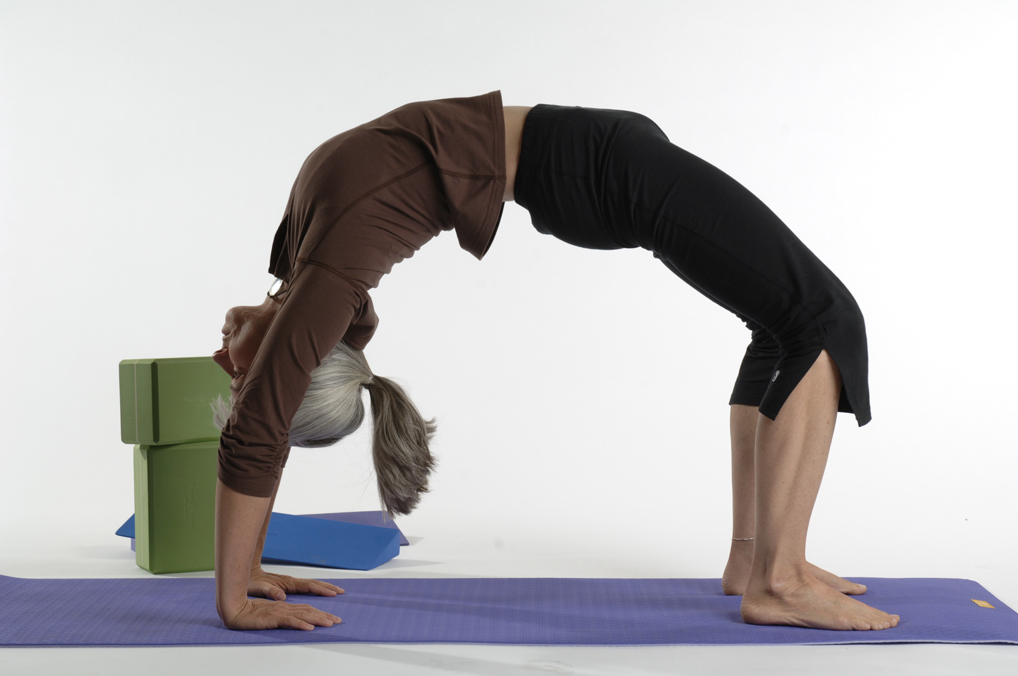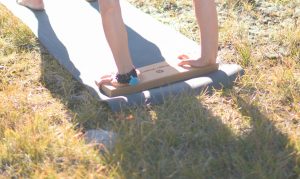
Backbends are one of yoga practice’s great gifts. Because our daily lives don’t require a lot of backbending, doing some sort of backbend every day is a way to balance our forward-folded lives. Plus they’re energizing and just plain fun.
Backbends take many forms, from smaller backbends such as Bhujangasana (Cobra Pose) to full-body backbends such as Urdhva Dhanurasana (Upward Bow), the subject of this post. All of them can be beneficial to our bodies. They mobilize our spines, lengthen our front bodies and strengthen our back bodies.
In Yoga International, teacher Rod Stryker writes:
“Urdhva Dhanurasana increases the vital force around the heart (pran), as well as the distributive force (vyana) throughout the body, thus increasing the breadth of courage and awareness. The pose stimulates both mind and body—the net result is exultation, awakening radiance, delight, and compassion.”
Urdhva Dhanurasana is not accessible to everyone, at least not in the form pictured above. As Paul Grilley says, “Yoga is in the bones.” This means that our bony structure, rather than our soft tissue flexibility, dictate our body’s ability to form many of the yoga asanas. Often when we think we’re “not flexible enough” to practice a certain pose, it often has nothing to do with flexibility. Instead, it’s simply how our joints are formed. When bone contacts bone at a joint site, you will move no further.
Our shoulder joints are all formed differently. Some people’s shoulder blades are formed so that the acromion processes (the little “beak” that sticks out on the lateral side) extend far out to the side. These people will likely not be able to extend their arms up vertically before their humerus bones hit the acromion process. This means that they likely won’t be able to straighten their arms, not because of soft tissue tightness, but because of a normal structural variation.

This is why I’ve never subscribed to the class-level restrictions that would prohibit someone from attending an “intermediate” or “advanced” class because they can’t perform Upward Bow with straight arms. This rule can eliminate people with deep, longstanding practices from classes and render them “beginners” for their entire lives. For me, this completely misses the point of practice. Now, off the soapbox and back to the post.
Even if you can’t straighten your arms in Upward Bow, you can still practice it. Props such as Yoga Wedges can help angle the arms in a way that allows them to straighten a bit more. But even if your arms never straighten, you can enjoy the pose.
Preparing for Urdhva Dhanurasana
Because Urdhva Dhanurasana requires flexibility throughout the entire front body, it’s important to prepare for it by practicing a few preparatory poses. Here’s a sequence that can be useful:
- Talasana (Palm Tree Pose, for stretching the side body and shoulders)
- Anjaneyasana (Lunge Pose, for stretching the quadriceps)
- Ardha Virasana (Half Hero’s Pose, for a deeper quadriceps stretch)
- Bhujangasana (Cobra Pose, a preparatory backbend)
- Setu Bandha Sarvangasana (Bridge Pose, a preparatory backbend)
Practice Urdhva Dhanurasana
- Lie on your back on a nonskid yoga mat with your knees bent and the soles of your feet on the floor.
- Take a few breaths to settle your body into the floor.
- Bend your elbows and place your hands on either side of your head with your forearms basically vertical and your fingers pointing slightly outward.
- Press your hands into the floor and push your whole body toward your feet.
- As your weight shifts a bit more from your shoulders to your legs, push with the hands and feet up into Upward Bow, arms bent or straight.
- Bend the knees and elbows to gently lower the body back to the floor.
- Relax for a few breaths and tune into the sensations you feel in your body.
- When you’re ready, repeat the process. I like to do at least two rounds, usually three, because your first Urdhva Dhanurasana is likely to feel pretty stiff. After a few rounds your body warms up to it.
This way of moving into the pose deviates from what I was taught for years. The usual way is to lift the hips, press the shoulder blades into your back and lift up using your arms. Because the legs are much stronger than the arms, I now push my weight into my legs, as above. It’s much easier. In fact, it’s the way I moved into the pose as a child when my sisters and I would do it in the yard for fun. This easier, more graceful way of moving into it was taught out of me in yoga classes. I’m grateful to Judith Hanson Lasater for reminding me of my original, intuitive way of moving into it.
After Urdhva Dhanurasana
Urdhva Dhanurasana is very heating and stimulating. For this reason, I usually don’t teach it in my classes that end later in the evening. Years ago, one student told me she was up vacuuming at 1:30 am after practicing Urdhva Dhanurasana in an evening class!
You can dampen some of the possible over-stimulation by practicing cooling poses after practicing Upward Bow. Here’s a short sequence:
- Jathara Parivartanasana (Revolved Belly Pose)
- Janu Sirsasana (Head-of-the-Knee Pose)
- Upavista Konasana (Seated Angle Pose)
- Paschimottanasana (Seated Forward Bend)
- Savasana (at least 10 minutes, but 15-20 would be better)
Remember that if your body never forms Urdhva Dhanurasana, your practice will not be incomplete. Asana practice has never been about what your body can or can’t do. It’s about your intention and the quality of attention you bring to whatever pose you’re practicing, no matter what it looks like. Whether you practice Cobra Pose or Upward Bow, relax, breathe and enjoy the benefits of backbending.
Updated article from March 3, 2017.
